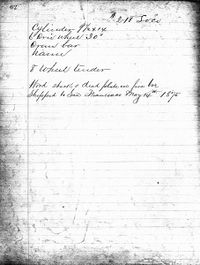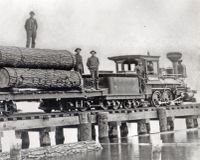HK Porter-CN-218-1875
California / Common Carrier / South Pacific Coast Railroad / Locomotives
History
Built by H.K Porter in 1875 for the Santa Cruz & Felton Railroad in California.
Specifications
| Porter Class | General Style of page 14 of 1889 catalog |
| Whyte | 0-6-0 |
| UIC | C n2 |
| Gauge | 36 in (914 mm) |
| Driver Dia. | 30 in (762 mm) |
| Loco weight | ?? short tons (??.0 t) |
| Fuel Type | Wood |
| Boiler Pressure | ?? psi (?? MPa) |
| Cylinders | Two, outside |
| Cylinder Size | 9½ in × 14 in (241 mm × 356 mm) |
Service
Santa Cruz & Felton Railroad
July 1875 to July 1881. Leased to the South Pacific Coast Railroad 1880. Sold to the Nevada & Oregon Railroad July 1881
South Pacific Coast Railroad
Leased from Santa Cruz & Felton Railroad 1880 to July 1881
Nevada & Oregon Railroad
Carson & Tahoe, Lumber & Fluming: Lake Valley Railroad
The Carson & Tahoe, Lumber & Fluming Company operated two railroads and needed additional locomotives for the Lake Valley Railroad on the south end of Lake Tahoe at Bijou. The former "Santa Cruz" worked out of Bijou primarily around the wharf where logs were dumped into the lake and hauled to the company mill at Glenbrook. In the late 1890s the supply of timber began to dwindle and the company decided to change their focus. They preserved their remaining timber holdings and drew up a new railroad that would serve the tourism business at Lake Tahoe. The Lake Valley Railroad was disassembled along with the Lake Tahoe Narrow Gauge and moved across the lake to Tahoe City. There the Lake Tahoe Railway & Navigation Company was built. The little #4 was no longer needed and sold to the Nevada County Narrow Gauge Railroad in 1898.
Nevada County Narrow Gauge Railroad
The former "Santa Cruz" was retired by the railroad after being heavily damaged by the Grass Valley engine house fire in August 1915. The locomotive was stored and slowly disassembled. The tender was retained and used behind NCNG #2 while the boiler was sold to a sawmill near Colfax, CA. Other parts including the frame and cylinders remained in the Grass Valley yard into the 1930s, possibly until the railroad was scrapped in 1942-43.




